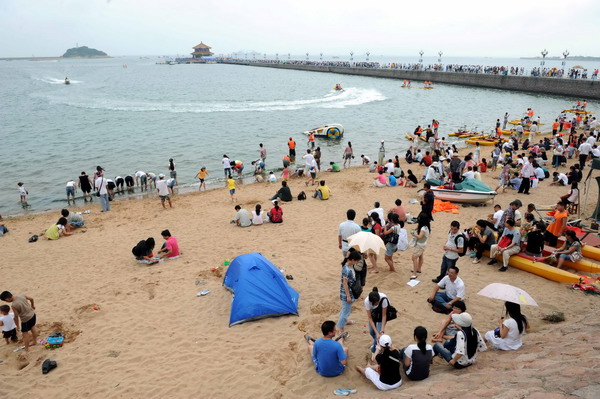8月5日傍晚开始,很多市民的朋友圈被这样一则信息刷屏:当天下午3时许,跟随妈妈从北京来青岛旅游的8岁双胞胎姐妹裴元槿和裴元桐在青岛西海岸新区万达公馆南侧沙滩玩耍时失联。当晚,青岛西海岸新区组织公安、边防、山海情救援联盟的队员们在沙滩、酒店和相关海域展开彻夜搜救,不少热心市民也加入。昨天上午,救援人员在离岸50多米远的海里先后发现了姐妹俩。令人痛心的是,她们紧闭的双眼,已经永远无法再睁开。
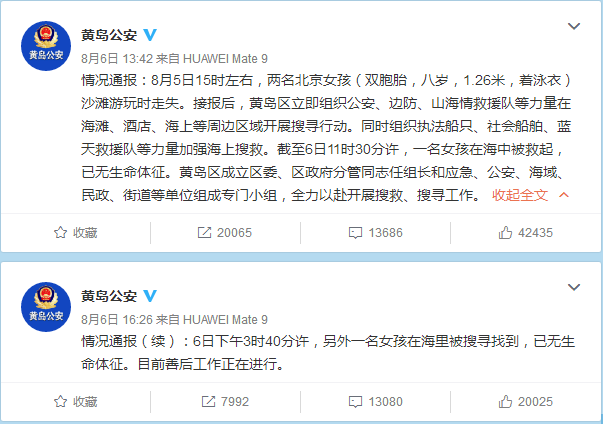
关于溺水女孩的报道及一些溺水知识双语:
Police in Qingdao, Shandong province, confirmed on Monday that 8-year-old twin girls who traveled from Beijing had been found drowned.
山东青岛警方8月6日确认,在青岛旅游的北京8岁双胞胎姐妹溺水身亡。
The twins - Pei Yuanjin and Pei Yuantong, according to reports - had come to the coastal city with their mother for a holiday.
据报道,这对双胞胎姐妹裴元瑾、裴元桐与母亲一起到海滨城市青岛度假。
A rescue team found the body of the elder twin around 11:30 am and the other at 3:45 pm in waters near the place the girls were reported missing.
8月6日上午11:30,搜救队在通报的失踪地点附近水域发现了姐姐的尸体,下午3:45发现了妹妹的尸体。
The twins' deaths drew wide concern on social media, with many comments warning of possible dangers. Some social media users, who seemed familiar with tidal currents in Qingdao, said the sea often ebbs at the time the twins vanished, and people can be carried off easily by the current.
这对双胞胎溺水身亡的消息在社交媒体上引起广泛关注,许多评论留言都提醒要留意潜在危险。一些似乎非常熟悉青岛海潮的网友说,这对双胞胎失踪期间正值海水退潮期,水流很容易将人卷走。
Drowning cases are known to increase in the summer months, especially in rural regions where rivers and pools are unpatrolled and children are often allowed to play unattended.
夏季是溺水事件的高发期,特别是在郊区,河流和池塘都疏于监管的地方,孩子们通常在无人照看的情况下玩水。
那么,遇到溺水时,应该如何自救或者救助他人?
Most of us think we know what drowning looks like. We’ve seen it on T.V. or in a movie. Right?
很多人都认为自己知道溺水是什么样子。我们在电视或电影上都看到过。对吧?
Someone is wildly flailing their arms and crying for help. That is how we know someone is in trouble.
溺水的人拼命拍打水面,大声呼救。这是我们的概念中所了解的溺水状况。
But is that reality?
但事实真的如此吗?
According to Dr. Frank Pia – over 20 years experience as a life guard – there is an instinctive drowning response that looks less like the movies and more like someone treading water. What are the signs of Instinctive Drowning Response?
据有20多年救生员从业经历的Frank Pia博士介绍,人溺水时有一种本能的反应,这种反应不怎么像电影中演的那样,而更像是在踩水。人本能的溺水反应有哪些表现?
Drowning is a silent killer. Victims may not be able to call for help because they are expending all of their energy trying to breathe or keep their head above water. When water is inhaled, the upper airway or larynx (voice box) may go into a spasm, making it difficult to cry for help.
溺水是个无声的杀手。溺水者往往无法呼救,因为他们要竭尽全力进行呼吸或将头部露出水面。一旦吸入水,上呼吸道或喉头可能会引发痉挛,很难发声呼救。
Victims of drowning usually do not thrash in the water as often depicted on television or in the movies. Most victims are found floating or submerged in the water.
溺水者通常不像电视或电影中演的那样拍打水面。大部分溺水者被发现时呈漂浮状或沉入水中。
The signs of drowning
溺水的迹象
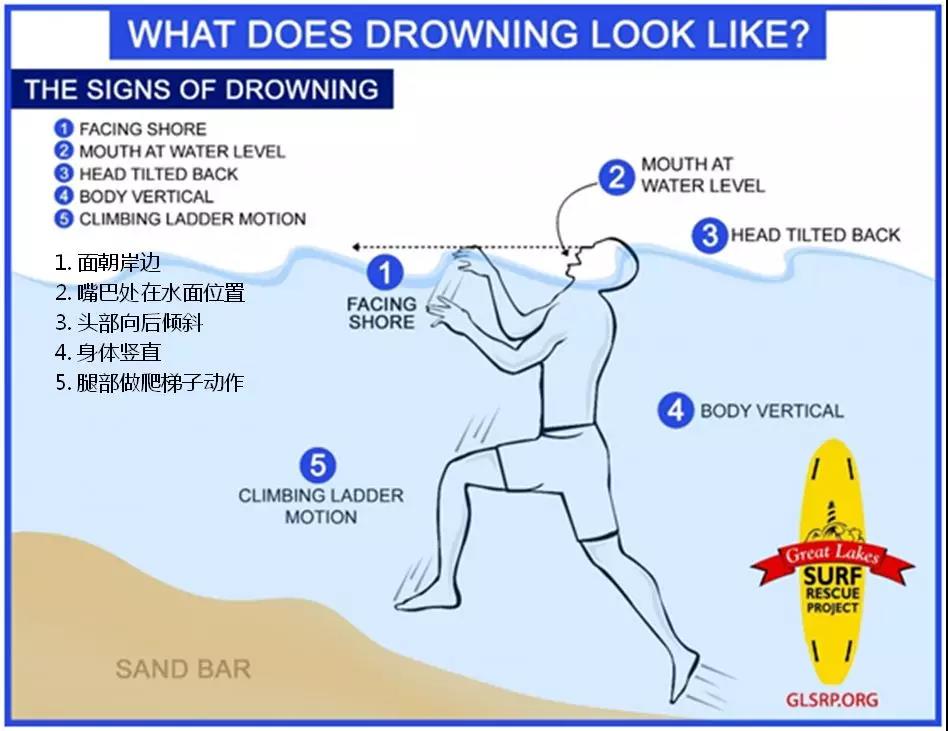
1. Except in rare circumstances, drowning people are physiologically unable to call out for help. The respiratory system was designed for breathing. Speech is the secondary or overlaid function. Breathing must be fulfilled before speech occurs.
除极少数情况外,溺水者从生理上几乎无法呼救。呼吸系统的构造是为了呼吸空气,讲话是次要功能或附加功能。只有当呼吸条件满足了,才能进行讲话。
2. Drowning people’s mouths alternately sink below and reappear above the surface of the water. The mouths of drowning people are not above the surface of the water long enough for them to exhale, inhale, and call out for help. When the drowning people’s mouths are above the surface, they exhale and inhale quickly as their mouths start to sink below the surface of the water.
溺水者的嘴时而没入水面,时而露出水面。他们的嘴无法长时间在水面保持呼吸,并大声呼救。当他们的嘴露出水面时,必须尽快呼吸,因为接下来嘴巴就要没入水面。
3. Drowning people cannot wave for help. Nature instinctively forces them to extend their arms laterally and press down on the water’s surface. Pressing down on the surface of the water permits drowning people to leverage their bodies so they can lift their mouths out of the water to breathe.
溺水者无法挥动胳膊求救。自然的身体反应本能地使他们向两侧张开手臂,将水面往下压,这样可以向上带动身体,使嘴巴露出水面呼吸。
4. Physiologically, drowning people who are struggling on the surface of the water cannot stop drowning and perform voluntary movements such as waving for help, moving toward a rescuer, or reaching out for a piece of rescue equipment.
从生理上讲,在水面挣扎的溺水者会不停呛水,无法自主挥手呼救、向施救者移动或者伸手获取救生设备。
5. From beginning to end of the Instinctive Drowning Response people’s bodies remain upright in the water, with no evidence of a supporting kick. Unless rescued by a trained lifeguard, these drowning people can only struggle on the surface of the water from 20 to 60 seconds before submersion occurs.
本能反应自始至终,溺水者的身体在水中一直处于直立状态,无任何迹象表明需要施救。除非是经过训练的救生员,否则溺水者只能在水面挣扎20-60秒,之后就会没入水中。
Drowning Survival Strategy
溺水求生策略
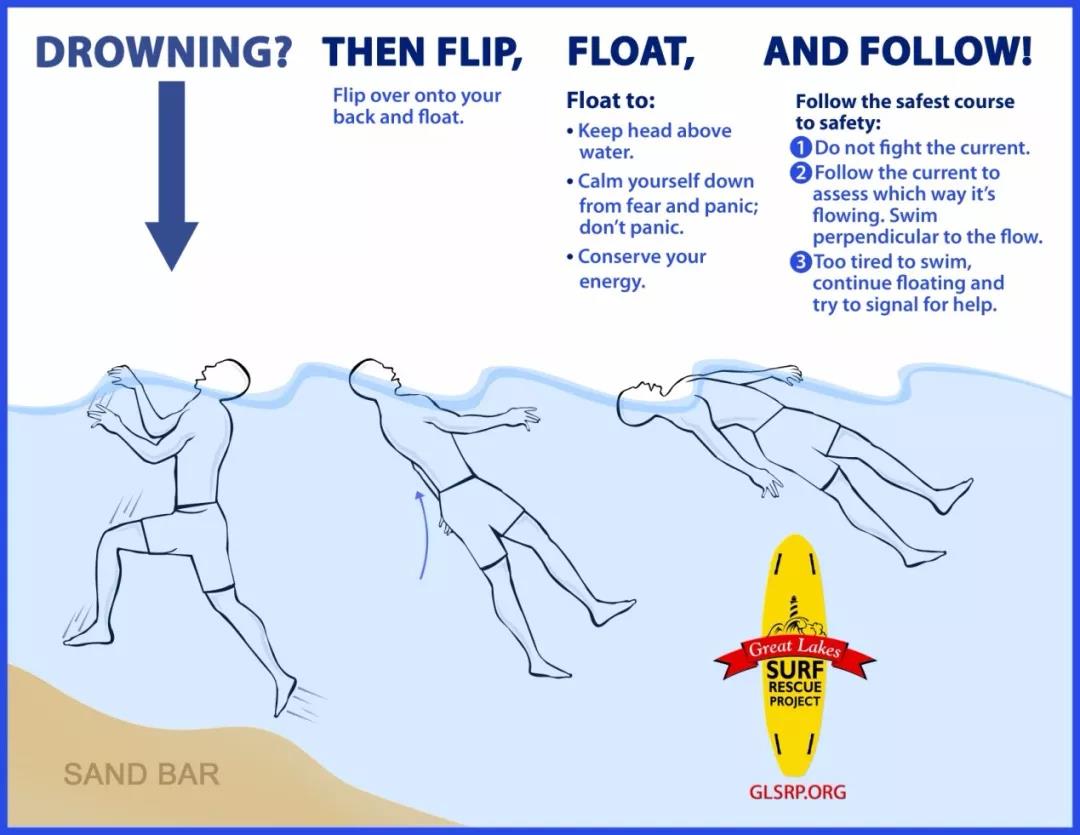
The Great Lakes Surf Rescue Project (GLSRP) announces its continued endorsement of the “Flip, Float, and Follow” Drowning Survival Strategy.
大湖区冲浪救援计划一直推崇“翻、浮、从”的溺水求生策略。
“As long as you are floating, you are alive and buying time for rescue to arrive,” said David Benjamin, executive director.
该计划执行理事大卫·本杰明说:“只要能浮在水上,你就能活下来,争取时间等待救援。”
“And the old rip current survival strategy, ‘Don’t panic swim parallel to shore’, may not always work because longshore currents run parallel to shore and structural currents run parallel to the structures (piers and jetty walls). It’s best to assess which way the current is pulling you before your risk swimming against it.”
“传统的离岸流求生策略让人们‘不要慌张,与海岸保持平行游动’,但此举并非屡试不爽,因为顺岸流与海岸平行,结构流的方向与结构(如防坡堤)一致,最好判断一下水流将你冲向何方,再决定是否冒险逆流而上。”
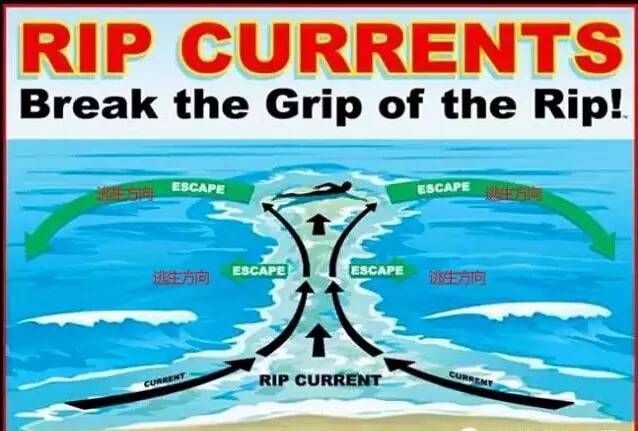
How to use the “Flip, Float, Follow” Drowning Survival Strategy – If you are ever caught in water over your head or a Dangerous Current:
如果你陷入没过头顶的水域或者危险的水流中,该如何使用“翻、浮、从”的溺水求生策略呢?
1. FLIP: “翻”
Flip over onto your back and float.
翻转身体,背朝下浮起来。
2. FLOAT: “浮”
A. Float to keep your head above water.
通过漂浮保持头部在水面之上。
B. Float to calm yourself down from the panic and fear of drowning.
通过漂浮让自己从慌乱和溺水的恐惧中冷静下来。
C. Float to conserve your energy.
通过漂浮保持体力。
3. FOLLOW: “从”
Follow the safest path to safety / out of the water.
随从最安全的路径脱离危险或离开水域。
A. Do not fight the current.
不要对抗水流。
B. Follow the current to assess which way it’s floating. Swim perpendicular to the flow.
跟从水流判断流向,朝与水流垂直的方向游动。
C. Too tired to swim, continue floating and try to signal for help.
无力游泳时,保持漂浮状态,设法发出求救信号。
REMEMBER:
切记:
As long as you are floating, you are alive.
只要浮在水面,你就能活下来。
As long as you are struggling or fighting a current, you are drowning – Conserve your energy and do not do the Signs of Drowning.
挣扎和逆流都会让你溺水——保持体力,避免“溺水迹象”。
Dry Drowning vs. Wet Drowning
干性溺水和湿性溺水
According to the World Health Organization, drowning is defined as "...the process of experiencing respiratory impairment from submersion/immersion in liquid. "While there may be dry or wet, depending upon whether some water is inhaled into the lungs.
根据世界卫生组织,溺水是指“在浸没/浸入液体中出现呼吸功能损害的过程” 。溺水又分为“干性溺水”和“湿性溺水”,取决于水是否被吸入肺部。
In the drowning sequence, laryngeal spasm occurs by water entering the upper airways. In most drowning cases, the spasm relaxes and water enters the lungs. Historically, this was known as a wet drowning. In 10% to 20% of drowning cases, the laryngeal spasm does not relax and no water enters. This was known as dry drowning. It is now felt that there is no clinical difference between wet and dry drowning and the distinction does not affect patient treatment or outcome.
溺水时,进入上呼吸道的水会引发喉部痉挛。多数情况下,痉挛会松弛,水会进入肺部,这就是所谓的“湿性溺水”。在10%-20%的溺水案例中,喉部痉挛无法松弛,没有水进入肺部,这就是“干性溺水”。两种溺水没有临床差异,二者的区别不影响患者治疗。
However breathing problems can be delayed as few as 1 hour to 24 hours after leaving the water. It is important then to note the symptoms of dry drowning.
不过,离开水后,呼吸问题可能滞后1至24小时出现。所以,留意“干性溺水”的症状十分重要↓
Difficulty breathing or shortness of breath
呼吸困难或呼吸短促
Chest pain
胸痛
Extreme fatigue
极度疲劳
Some children have had loss of bowel or bladder control
一些孩子的肠道或膀胱失控
Persistent coughing
持续咳嗽
Change of mood
情绪变化
Fever
发热
这些基础的救援方法可以在关键时刻拯救生命,希望你和身边的人都能掌握。
以下给出青岛8所正规海水浴场,夏天下海还是需要去正规的海水浴场玩。
目前,青岛市正规设立的海水浴场有第一海水浴场、第二海水浴场、第三海水浴场、第六海水浴场、石老人海水浴场、金沙滩海水浴场、银沙滩海水浴场、灵山湾(城市阳台)海水浴场等共8处。
青岛市城市管理局提醒,其他所谓的“野浴场”,均为属地管理的沙滩,并非海水浴场,没有任何浴场的配套设施和救生救护人员及医护保障人员,希望游客为了自身安全和家人,不要到这种所谓的浴场进行游泳。
第一海水浴场
一浴位于汇泉湾,始建于1899年。一浴沙平面广,没有暗礁隐壑和旋涡,很受市民及游客欢迎。高峰时,每天可接纳25—30万人入浴,最高时日接待量曾达35万人次。
第二海水浴场
二浴位于汇泉湾东侧的太平湾内,又称“太平角海水浴场”,与八大关别墅区相邻,建于1934年。二浴坡缓、沙软、浪小、水净,岸滩面积大,许多国家领导人及外国元首等,都曾在这里畅游过。
第三海水浴场
三浴位于太平角东侧,建于1934年。三浴规模虽不大,但海水却非常清澈。沙滩上建有一幢幢风格多样的更衣室,更衣室冲浴的水是热水,很适合不习惯冷水冲浴的人。因为风景很好,也是拍摄婚纱照的热门取景地。
第六海水浴场
六浴位于太平路栈桥之西,毗邻火车站,又称“栈桥海水浴场”。许多从未见过大海的外地人,初识大海便是在这里。六浴的海岸线是青岛最美的地方之一,浴场沙滩的沙子大部分是新换的,沙质细软,尤其适合沙滩嬉戏。
石老人海水浴场
石老人海水浴场位于崂山区海尔路南端,是青岛市区最大的海水浴场之一。浴场左端海中17米高的石柱是基岩海岸典型的海蚀柱景观,外形如老人坐在碧海之中,故称“石老人”,是青岛非常著名的景点。石老人海水浴场还被评为中国最美的日出地之一。

金沙滩海水浴场
金沙滩海水浴场在黄岛金沙滩旅游度假区内,金沙滩是我国沙质最细、面积最大、风景最美的海水浴场之一,被称为“亚洲第一滩”。
银沙滩海水浴场
青岛银沙滩位于青岛开发区凤凰岛旅游度假区西南侧,与金沙滩为姊妹滩,全长2000余米,呈月牙形状,东西伸展,水清滩平,是天然的海水浴场。
灵山湾海水浴场
位于西海岸新区城市阳台,每年9月份都有拉网捕鱼活动,游客量逐渐增多。今年开始,位于海水浴场西侧的中央公园开始建设,占地近5000亩。
青岛八大海水浴场位置及服务监督电话
第一海水浴场 青岛汇泉湾 82963355
第二海水浴场 汇泉湾东侧的太平湾内 66577309
第三海水浴场 太平角东侧、湛山湾畔 66577319
第六海水浴场 东临栈桥、西接海上皇宫、北靠太平路、南边与小青岛隔海相望 82868575
石老人海水浴场 东起蓝色风帆雕塑西侧入口处至石老人海水浴场东停车场正前 88894195
金沙滩海水浴场 开发区凤凰岛旅游度假区中部 86707399
银沙滩海水浴场 凤凰岛国家级旅游度假区的西南部 89602009
灵山湾(城市阳台)海水浴场 黄岛区城市阳台景区 83978302




